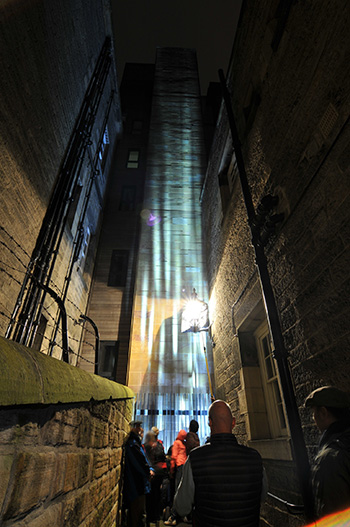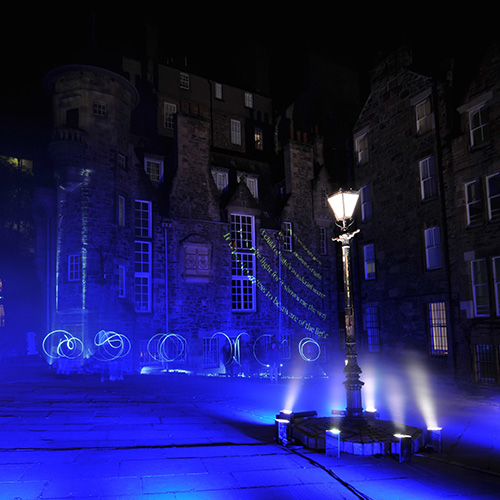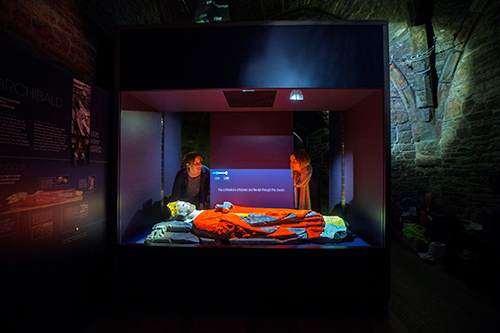Researchers shine spotlight on historic Edinburgh
Edinburgh’s Botanic Gardens and its historic closes have been part of the city’s DNA for centuries.
Among the top attractions that the city has to offer, both are much loved by visitors year-on-year.
In an effort to ensure they remain two of Scotland’s most popular visitor destinations, both have recently undergone transformations to encourage new visitors to view them in a different light.
Two projects – Botanic Lights and Twelve Closes – have harnessed the knowledge and dynamic expertise of a team of Edinburgh Napier lighting academics to open both attractions up to a new audience.
The researchers have come together with a number of organisations, businesses and bodies to use creative thinking and advancements in technology to ensure that the future of each attraction is as bright as its illustrious past.
Botanic Lights
Running over 23 nights in 2014, the ‘Botanic Lights’ project was conceived as a research and design-led response to a need to increase visitors and generate income streams for the Royal Botanic Garden Edinburgh (RBGE).
The principal output was ‘A Night in the Garden’; a temporary light art installation that explored a number of research themes led by Edinburgh Napier’s
Malcolm Innes and Euan Winton.
Using lighting, narrated journeys and communications, the Gardens were transformed into a temporary visitor experience. A 1km route through the heart of the gardens was conceived, with visitors taking in a total of 19 artistic concepts as they made their way through at night.
Funded by the Scottish Funding Council and supported by Homecoming Scotland, the project had a significant impact on both daytime and night time visitor numbers, with a total of 23,500 visitors attending in its first year.
Due to this success, the event returned for a second, expanded run in 2015 and provided numerous opportunities for Edinburgh Napier students to develop course work and their practice based portfolio – one even gained paid employment as a result.
The second year event also saw the first collaboration of its kind between Edinburgh Napier researchers in Design and Music. The result was an experimental music score developed by Dr Haftor Medboe that gave structure for one of the light performances, designed for the pond area of the gardens.
Through the testing of ideas and approaches, the project has richly informed ongoing work in the built environment that Malcolm Innes and Euan Winton are undertaking with a number of local, national and international bodies. It has directly led to other practice-based research projects for Dunbar Science Festival among others.
Botanic Lights: some statistics
Twelve Closes
Spearheaded by Edinburgh World Heritage Trust (EWH), the Twelve Closes project will see a series of innovative improvements made toW a range of selected closes in an effort to encourage greater use by the public.
Through a process of community co-design, Edinburgh Napier’s Euan Winton and Malcolm Innes will work directly with local communities to research the history of each close to provide ideas and design inspiration for their revitalisation.
Through the use of new artwork, lighting, projection and interpretation, the project aims to reveal the unique charm and atmosphere of each individual close so that they can be reclaimed as useful pedestrian links around the city.
A demonstration event has already been held in the city’s Bakehouse Close in November 2015, with staff and students from Edinburgh Napier taking over the space at night to showcase how artistic and architectural lighting could be used.
The project was widely praised, with valuable input from residents, visitors, local business owners, politicians, heritage groups and other stakeholders gathered to help steer the project’s direction.
Malcolm added: “Work continues to progress with the Twelve Closes Project and we’re delighted to be involved in what we are sure will bring significant positive change to the historic part of the city.
“We’re currently working with key partners and the local community to fully understand the history of the closes with an aim of using these ideas as inspiration for the final lighting designs. It’s important not to forget the past as we look to breathe new life into these key locations in the future.”
The final selection of closes is still under discussion, but the current shortlist includes Riddle’s, Crichton’s and Stevenlaw’s Closes among others.
Although the main output of the project will be the physical transformation of the closes, it is expected to have a much broader impact on the pattern of tourism within the Old Town. It is expected to fully engage residents in the co-design and ongoing curation to these spaces, with the project forming the basis of practice-based academic research in the areas of urbanism, community co-design and lighting design for heritage environments.
We’re currently working with key partners to understand the history of the closes. It’s important not to forget the past as we look to breathe new life into these key locations in the future.
Night of Heritage Light
Working in partnership with the Society of Light and Lighting, Euan Winton and Malcolm Innes were responsible for the Edinburgh Leg of an ambitious project to illuminate nine of the UK’s UNESCO World Heritage sites on one night in October 2015.
As part of the Night of the Heritage Light project, Malcolm and Euan took the lead in lighting up the city’s Writers’ Museum and parts of Makars’ Court. The areas were reimagined as a landscape of light where the power of the written word radiated into the local environment.
A rousing success across all nine sites, the project came top in the Best Creative Light Event category at the 2015 Darc Awards.
Malcolm Innes said: “The UNESCO Night of Heritage Light was a fantastic project to be involved with and we’re delighted that our work in Edinburgh has helped contribute to its subsequent success.
“Within our project specifically, we worked closely with Edinburgh Napier alumni Steven and David McConnachie of Double Take Projections alongside a group of our current MA/MDes students. It was a real team effort and it’s extremely satisfying for the project to be recognised by our fellow peers in the lighting profession.”
Elgin Cathedral and carved stone interpretation
In 2012, working in collaboration with Historic Scotland, Edinburgh Napier’s Richard Firth and Malcolm Innes started developing plans for a new immersive exhibition, telling the story of Elgin cathedral and the people who built it.
Through the redisplay and the interpretation of the Elgin Stone collection, which has been documented and studied by conservators and researchers, the completed exhibition reopened in 2016, enabling visitors to view the stones and explore the wonderful carvings.
Spread across eight rooms in the cathedral’s north and south towers, the challenging project saw a range of LED lighting integrated into interpretive display structures to illuminate the stones and bring the entire exhibition to life.
It now offers a rare glimpse into what Elgin Cathedral could have looked like some 700 years ago, with the stones, which lay buried amidst the ruins of the cathedral until the 1800s, now front and centre of its attention.
Study at Edinburgh Napier